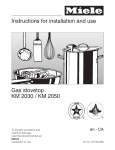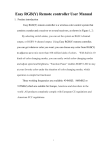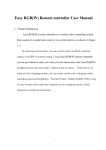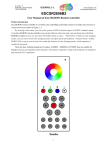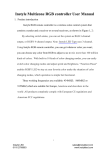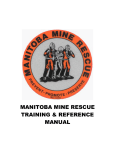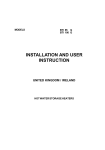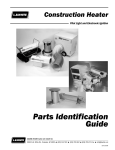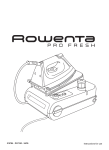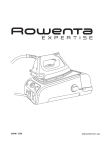Download Miele KM 2030 Specifications
Transcript
Installation Instructions KM2030 en-CA IMPORTANT: SAVE FOR THE LOCAL ELECTRICAL INSPECTOR'S USE To prevent accidents and machine damage read these instructions before installation or use. Installation, repair and maintenance work should be performed by a Miele authorized service technician in accordance with national and local safety regulations and the provided installation instructions. SAFETY NOTICES FOR INSTALLATION To avoid damage to the appliance, it should not be installed until the upper cabinet and exhaust hood have already been mounted. ~ This appliance is not connected to an exhaust vent. It must be installed and connected to the power supply in compliance with the applicable installation requirements. ~ The room will need to be at least 20 m3 in volume, with at least one door or window opening to the outside. ~ The countertop veneers must be affixed with heat-resistant glue (100 °C), so that they do not become deformed or detached. The wall strips must be heat-resistant as well. ~ Installation and assembly of this appliance in non-stationary locations (for example, aboard ships) should be performed only by specialized companies/technicians, to ensure that the requirements for safe use are met. ~ Because there is the risk of flameover, a gas cooktop should NEVER be installed next to a deep-fryer. A minimum distance of 12" (300 mm) must be maintained between these appliances. Other appliances may be build in directly next to the gas cooktop. 26 ~ Storage cabinets above the cooktop present a fire hazard. ~ This gas cooktop is not authorized for installation atop refigerators/freezers, dishwashers, or washers/dryers. ~ Check to be sure that the gas line and power cord will not come into contact with any hot spots after installation. Hot spots can cause heat damage to the gas line and power cord. ~ The power cord and a flexible gas line must be arranged in such a way that they will not come into contact with moveable parts in the cabinetry (e.g., a drawer) or be subject to any mechanical strain. ~ Be sure to carefully observe the clearance distances listed on the following pages. ~ Never use caulking unless it is explicitly called for in the instructions. The sealing tape for the appliance provides an adequate seal with the countertop (see the section on "General installation notices"). SAFETY NOTICES FOR INSTALLATION Upper clearance If there are various appliances with different recommended clearance distances beneath the exhaust hood, e. g., a gas stovetop and an electric cooktop, always choose the greatest distance. For an exhaust hood above the appliance, the safe clearance distance indicated by the hood manufacturer must be maintained. If there are no specifications from the hood manufacturer or if flammable materials (e. g., a hanging cabinet) are installed above the appliance, the clearance distance must be at least 30" (760 mm). The maximum depth of cabinets installed above the cooktop must be 13" (330 mm). Miele appliances can be installed flush or proud. Discuss your installation requirements with you architect, designer and installer. 27 SAFETY NOTICES FOR INSTALLATION When installing a gas stovetop, the cabinetry or walls to ONE side and to the rear of the appliance can be as tall as you wish. However, on the other side there must not be any appliance or furniture that is taller than the installed gas stovetop (see illustrations). You must ensure that the following minimum safety clearances are kept: – 4" (100 mm) to the right or left of the countertop cut-out to the next closest piece of furniture (e.g., tall cupboard). 2” Highly recommended – 2" (50 mm) from the countertop cut-out to the rear wall. Not recommended Not permitted 28 Appliance and installation dimensions KM 2030 a front b Installation height c Gas connection R 1/2" ISO 7-1 d Junction box with power cable, L = 78 3/4" (2000 mm) 29 Appliance and installation dimensions KM 2050 a front b Installation height c Gas connection R 1/2" ISO 7-1 d Junction box with power cable, L = 78 3/4" (2000 mm) 30 Installation How to make the countertop cut-out How to install the gas stovetop ^ Use the template to make a countertop cut-out. Be sure to observe the minimum distance from the rear wall and from the left or right to a side wall. See the section on "SAFETY NOTICES FOR INSTALLATION". ^ Seal any wooden countertop surfaces with a special varnish, silicone rubber, or resin, to help prevent swelling from moisture. The materials used must be temepature-stable. If, during installation, you find that the frame is not tightly sealed to the countertop at the corners, then the corner edges, ß R4, can be carefully trimmed with a jigsaw. ^ Feed the appliance power cord downward through the countertop cut-out. ^ Set the appliance loosely into place in the cut-out. ^ Connect the appliance to the power supply (see the section on "Electrical connection"). ^ Establish the gas connection (see the section on "Gas connection"). ^ Use the supplied brackets to hold the appliance in place. 31 General installation information Sealing Tiled surfaces NEVER use sealing unless it is explicitly called for in the instructions. The sealing strip under the edge of the upper part of the appliance provides a sufficient seal against the countertop. The grouting a and shaded area under the cooktop frame must be flat and even, so that the frame will lie evenly and the sealing strip under the edge of the upper part of the appliance can provide an adequate seal against the countertop. NEVER use sealing between the upper appliance frame and the countertop! It will hinder access to the appliance during servicing, and the frame and countertop can be damaged as a result. 32 Electrical connection This appliance must be grounded according to local or national codes. All electrical work should be performed by a qualified electrician in accordance with local codes and with the: - National Electrical Code ANSI / NFPA 70 for the USA or - Canadian Electrical Code Part I for Canada (CSA Standard C 22.1) ,WARNING Disconnect the appliance from the main power supply before installation or service. To reduce the risk of electric shock, make sure that the appliance is properly grounded after installation. This appliance is equipped with a three-prong grounding plug to prevent shock hazards. It should be plugged directly into a properly grounded outlet. Do not cut or remove the grounding prong from the plug. If the plug does not fit the outlet, have the proper outlet installed by a licensed electrician. To guarantee the electrical safety of this appliance, continuity must exist between the appliance and an effective grounding system. It is imperative that this basic safety requirement be met. If there is any doubt, have the electrical system of the house checked by a qualified electrician. The manufacturer cannot be held responsible for damages caused by the lack, or inadequacy, of an effective grounding system. Power supply The automatic ignition requires that the appliance be connected to a 120 VAC, 60 Hz power supply. The supply line should be protected by a 15 A fuse. Note to the installer Please leave these instructions with the consumer or the appliance. Actual power consumption (during ignition only) is 25 W. This appliance is equipped with a 78 3/4" (2000 mm) long power cord that is ready for connection to the appropriate outlet. Place the power outlet so that it is accessible after the appliance has been installed in the countertop. 33 Gas connection Installation and service must be performed by a qualified installer, service agency or the gas supplier. The gas connection must be made in accordance with local codes or, in the absence of local codes, with This appliance must be installed with its own shut off valve and the included gas pressure regulator. Both the valve and the regulator must be easily accessible to the consumer to turn on or shut off the gas supply after the appliance is installed. - This appliance and its individual shut off valve must be disconnected from the gas supply during any pressure testing performed in excess of ½ psi (3.5 kPa), or isolated from the gas line by closing its individual manual shut off valve at test pressures equal to or less than ½ psi (3.5 kPa). Any pipe connections must be made using a thread sealant approved for gas connections. Failure to correctly install these items could lead to a gas leak and subsequent explosion. Leak testing of the appliance shall be conducted according to the manufacturer's instructions. 34 the National Fuel Gas Code, ANSI Z 223.1/NFPA 54 for the USA or - the current Can/CGA B 149.1 and .2 Installation Codes for gas burning appliances for Canada. Make sure that the maximum gas supply pressure before the gas pressure regulator is never more than ½ psi for both natural gas or LP gas. The minimum supply pressure to get the required gas input is 4" w.c. for natural gas: 10" w.c. for LP gas. Gas connection Gas pressure regulator A pressure regulator that is convertible from natural to LP gas (Propane) or vice versa is included with the appliance. The included regulator corresponds with the gas type of the appliance. Verify before installing. The adjusted pressure is: natural gas - 4" w.c. LP gas - 10" w.c. For convenience, an AGA or CGA approved flexible stainless steel gas hose (accordion type) may be used between the gas connection and the regulator. This will allow the appliance to be lifted out of the countertop for cleaning or servicing. Make sure that any drawers, cabinet doors, etc., do not rub on this gas hose. Do not use any regulator unless it has been supplied by Miele. Doing so may cause a gas leak. If there is any doubt concerning installation contact the Miele Technical Service Department. After connecting the appliance check all fittings for gas leaks e.g. with soapy water. a Appliance b ½" NPT When installed properly, the flame will be steady and quiet. It will also have a sharp, blue inner core that will vary in length proportional to the burner size. Flame adjustment will not be necessary. c Regulator As shown in the above diagram, the included regulator must be used when connecting the Miele appliance to your gas supply. This item has been customized by Miele to meet all applicable safety requirements. Make sure the regulator is easily accessible for adjustment after the appliance has been installed. 35 Gas connection The appliance should have been ordered for connection to either natural gas or LP gas (propane). If the appliance is not configured for the proper type of gas connection please contact your Miele Dealer. If the appliance is to be connected to a type of gas other than it was originally configured for, both the regulator and burners must be converted. A conversion kit is available as an optional accessory from the Miele Technical Service Department. 36 Burner performance Rated load at high setting Burner Type of gas KM 2030 KM 2050 BTU/hr kW BTU/hr kW Small burner Natural gas (NG) Liquid gas (LP) 3500 3500 1,00 1,00 3500 3500 1,00 1,00 Regular burner Natural gas (NG) Liquid gas (LP) 6200 5800 1,80 1,70 6200 5800 1,80 1,70 Power burner Natural gas (NG) Liquid gas (LP) - - 8900 8900 2,60 2,60 Wok Natural gas (NG) Liquid gas (LP) 12000 11000 3,50 3,20 12000 11000 3,50 3,20 Total Natural gas (NG) Liquid gas (LP) 27900 26100 8,10 7,60 36800 35000 10,70 10,20 Rated load at low setting Burner Type of gas KM 2030 / KM 2050 BTU/h kW Small burner Natural gas (NG) Liquid gas (LP) 850 850 0,25 0,25 Regular burner Natural gas (NG) Liquid gas (LP) 1200 1200 0,35 0,35 Power burner Natural gas (NG) Liquid gas (LP) 1700 2000 0,50 0,60 Wok Natural gas (NG) Liquid gas (LP) 3700 3700 1,10 1,10 37 How to switch to a different gas type ,Switchover to a different gas type should only be performed by a duly authorized gas company technician. Save the nozzles removed from the appliance for future use. Nozzle table If you switch to a different type of gas, the large and small burner nozzles will need to be changed. Main nozzle Ø Low setting nozzle Ø 0,90 1,13 1,45 1,63 0,42 0,52 0,60 1,30 (1A) 0,58 0,72 0,90 0,98 0,27 0,32 0,40 0,60 Natural gas (NG) Small burner Regular burner Power burrner Wok Liquid gas (LP) Small burner Regular burner Power burrner Wok The nozzle listings are for a 1/100mm bore diameter. 38 How to switch to a different gas type How to change a nozzle Small, normal, and power burners Unplug the appliance from the electrical supply. How to change the main nozzle ^ Remove the burner cover b, the burner ring a (wok) and the burner head c. ^ Use a socket wrench (M7) to unscrew the main nozzle h. ^ Insert the proper nozzles (see Nozzle table) and tighten them down. Wok burner 39 How to switch to a different gas type How to change the small nozzles (all burners) To change the small nozzles, you will first need to remove the upper part of the appliance. a ^ Unscrew the mounting screws on the burner. ^ Pull the control knob up and off. ^ Take off the upper part of the appliance. ^ Remove the ignition switch a. ^ Use a small screwdriver to unscrew the small nozzle b from the gas tap. ^ Use needle-nosed pliers to pull the nozzle out. ^ Insert the proper nozzles (see Nozzle table) and tighten them down. 40 b How to switch to a different gas type After switching over ^ Use the reverse order to re-assemble the burner parts. ^ Before putting the upper part of the appliance back in place, light each burner with matches to test the seal on all the gas flow parts. ^ After testing, set aside the loose burner parts. ^ Put the upper part of the appliance back in place. ^ Screw down the lower part of the burner, then put the loose burner parts back into place, making sure to follow the right order. ^ Put the control knob back on. ^ Finally, check the flame behaviour of each burner. The flame must not go out in the low setting, even if the control knob is quickly turned from "high" to "low". At the high setting, the flame needs to burn with a clearly visible core. ^ In the nozzle pack, find the appropriate sticker for the new gas type and stick it over top of the previous sticker. 41 Alteration rights reserved / 4908 For the most updated manual see the Miele web site. M.-Nr. 07 520 080 / 00


















